Experimental Study on the Corrosion of Fulvic Acid to Cement-Soil and Its Microstructures in the Peat Soil Environment
Abstract
:1. Introduction
2. Materials and Methods
2.1. Materials
- Test soil
- 2.
- Cement
- 3.
- HA reagent
- 4.
- FA reagent
- 5.
- Test water
2.2. Experimental Design and Sample Preparation
2.3. Experimental Procedure
- SEM test
- 2.
- MIP test
- 3.
- PCAS test
- 4.
- UCS test
3. Results and Analysis
3.1. SEM Test Results and Analysis
3.2. MIP Test Results and Analysis
3.3. PCAS Analysis of Test Results
3.4. UCS Test Results and Analysis
4. Conclusions
- (1)
- The structural characteristics and strength of cement-soil were shown to change over time when exposed to deionized water and peat soil environments. In the presence of deionized water, the structural characteristics of cement-soil exhibited a gradual enhancement followed by a slight weakening. Conversely, when exposed to peat soil, the strength of cement-soil experienced a slow initial increase due to the gelling and filling effects of fulvic acid. However, as time progressed, the corrosive impact of fulvic acid resulted in the deterioration of the cement-soil structure. Consequently, the strength exhibited a pattern of gradual increase followed by a rapid decrease.
- (2)
- To enhance the durability of cement-solidified soil in peat soil environments, it is essential to adhere to the principles of cost-effectiveness, environmental consciousness, and sustainability. This entails selecting cost-efficient and pragmatic additives that can fortify the structure of cement-soil, decelerate the penetration rate of corrosive substances such as fulvic acid, and enhance its impermeability to withstand corrosion in peat soil environments.
Author Contributions
Funding
Institutional Review Board Statement
Informed Consent Statement
Data Availability Statement
Conflicts of Interest
References
- Gui, Y.; Fu, J.; Wu, C.K.; Cao, J.; Gao, Y.F. Hydraulic conductivity of lacustrine peaty soil in plateau areas and its mechanism analysis. Rock Soil Mech. 2016, 37, 3197–3207. [Google Scholar]
- Wang, D.W.; Wang, Q.; Chen, J.P. Research on the distribution regularity and the engineering geological property of peat soil in Dianchi basin. In Proceedings of the 2nd National Geotechnical and Engineering Academic Conference, 28 October–1 November 2006, Wuhan, China; Science Press: Beijing, China, 2006; pp. 831–835. [Google Scholar]
- Xue, Y.; Cui, W.X.; Feng, Z.J.; Chen, J.W. The reinfforcement technology of railway’s soft soil foundation in Dian Lake area. J. Railw. Eng. Soc. 2015, 32, 35–40. [Google Scholar]
- Tremblay, H.; Duchesne, J.; Locat, J.; Leroueil, S. Influence of the nature of organic compounds on fine soil stabilization with cement. Can. Geotech. J. 2002, 39, 535–546. [Google Scholar] [CrossRef]
- Fan, Z.P.; Zhu, W.; Zhang, C.X. Experimental study on influence of organic matter content on solidified dredging. Rock Soil Mech. 2005, 26, 1327–1330+1334. [Google Scholar]
- Feng, C.; Wang, B.T.; Li, S.D. Experimental study on solidified organic sludge. Geotech. Eng. Tech. 2010, 24, 142–146. [Google Scholar]
- Xun, Y. The anti-influences and influences of containing organic matter on cement soil strength. Build. Sci. Res. Sichuan 2000, 3, 58–59. [Google Scholar]
- Cao, J.; Song, Y.F.; Gao, Y. Preliminary experimental study on the corrosiveness of humic group to cement-soil. J. Saf. Environ. 2022, 1–10. [Google Scholar] [CrossRef]
- Gong, G.Q.; Xu, L.W.; Zhang, Y.J.; Liu, W.X.; Wang, M.; Zhao, Y.F.; Yuan, X.; Li, Y.J. Extraction of fulvic acid from lignite and characterization of its functional groups. ACS Omega 2020, 5, 27953–27961. [Google Scholar] [CrossRef]
- El Howayek, A.; Bobet, A.; Santagata, M. Microstructure and cementation of two carbonatic fine-grained soils. Can. Geotech. J. 2019, 56, 320–334. [Google Scholar] [CrossRef]
- Yao, K.; Wang, W.; Li, N.; Zhang, C.; Wang, L.X. Investigation on strength and microstructure characteristics of nano-MgO admixed with cemented soft soil. Constr. Build. Mater. 2019, 206, 160–168. [Google Scholar] [CrossRef]
- Ruan, B.; Ding, H.; Teng, J.D.; Deng, W.; Zheng, S.L.; Ruan, C.X. Mechanical properties and microstructure of polypropylene fiber reinforced cement mortar soil. KSCE J. Civ. Eng. 2021, 25, 1985–1997. [Google Scholar] [CrossRef]
- Jiang, N.; Wang, C.M.; Wang, Z.P.; Li, B.L.; Liu, Y.A. Strength characteristics and microstructure of cement stabilized soft soil admixed with silica fume. Materials 2021, 14, 1929. [Google Scholar] [CrossRef]
- Chen, Z.; Xu, H.C.; Cheng, M.Y.; Lu, H.W.; Wang, Z.J.; Feng, P.Y. Dynamic triaxial test and microscopic study of solidified muddy soil with different mixing ratios and curing ages. Front. Mater. 2021, 8, 731449. [Google Scholar] [CrossRef]
- Chen, Q.S.; Yu, R.H.; Tao, G.; Nimbalkar, S. Microstructure, strength and durability of nano-cemented soils under different seawater conditions: Laboratory study. Acta Geotech. 2022, 18, 1607–1627. [Google Scholar] [CrossRef]
- Hu, X.P.; Zhao, Z.H. Study on water retention property of cemented dredged material based on MIP. Yellow River 2016, 38, 116–119. [Google Scholar]
- Qu, Z.K.; Wang, H.J.; Xun, W.F.; Liu, G.S.; Bian, H.B. Study on permeability characteristics of modified soil based on mercuey intrusion. South-North Water Transf. Water Sci. Technol. 2017, 15, 172–178. [Google Scholar]
- Bozbey, İ. Microfabric evaluation of lime-treated clays by mercury intrusion porosimetry and environment scanning electron microscopy. Int. J. Civ. Eng. 2018, 16, 443–456. [Google Scholar] [CrossRef]
- Chen, X.; Liu, X.; Dong, S.H.; Ge, Y. Cement hydration and pore structure development in low arioressure and low humidity. J. Xi’an Univ. Archit. Technol. 2021, 53, 202–207. [Google Scholar]
- Song, Y.F.; Cao, J.; Ding, W.Y.; Song, Z.G.; Liu, H.; Huang, S.Y.; Zhu, W.M. Influence of peat soil environment on mechanical properties of cement-soil and its mechanism. Sustainability 2023, 15, 4580. [Google Scholar] [CrossRef]
- Cao, J.; Huang, S.Y.; Liu, W.L.; Kong, C.; Gao, Y.; Liu, F.Y. Study on simulation test of peat soil environment in Dianchi Lake. Adv. Civ. Eng. 2022, 2022, 1437733. [Google Scholar] [CrossRef]
- GB/T 50123-2019; Ministry of Water Resources of the People’s Republic of China. Standard for Geotechnical Testing Method. China Planning Press: Beijing, China, 2019.
- Cao, J.; Huang, S.Y.; Liu, W.L.; Gao, Y.; Song, Y.F.; Li, S.P. Study on strength development and microstructure of cement-solidified peat soil containing humic acid of Dianchi Lake. Adv. Mater. Sci. Eng. 2022, 2022, 8136852. [Google Scholar] [CrossRef]
- Stevenson, F.J. Humus Chemistry: Genesis, Composition, Reactions; John Wiley & Sons: New York, NY, USA, 1994. [Google Scholar]
- Shao, Y.F. Study on Humus-Containing Soil Stabilization; Zhejiang University: Hangzhou, China, 2006. [Google Scholar]
- Jones, M.N.; Bryan, N.D. Colloidal properties of humic substances. Adv. Colloid Interface Sci. 1998, 78, 1–48. [Google Scholar] [CrossRef]
- Lee, C.L.; Kuo, L.J.; Wang, H.L.; Hsieh, P.C. Effects of ionic strength on the binding of phenanthrene and pyrene to humic substances: Three-stage variation model. Water Res. 2003, 37, 4250–4258. [Google Scholar] [CrossRef] [PubMed]
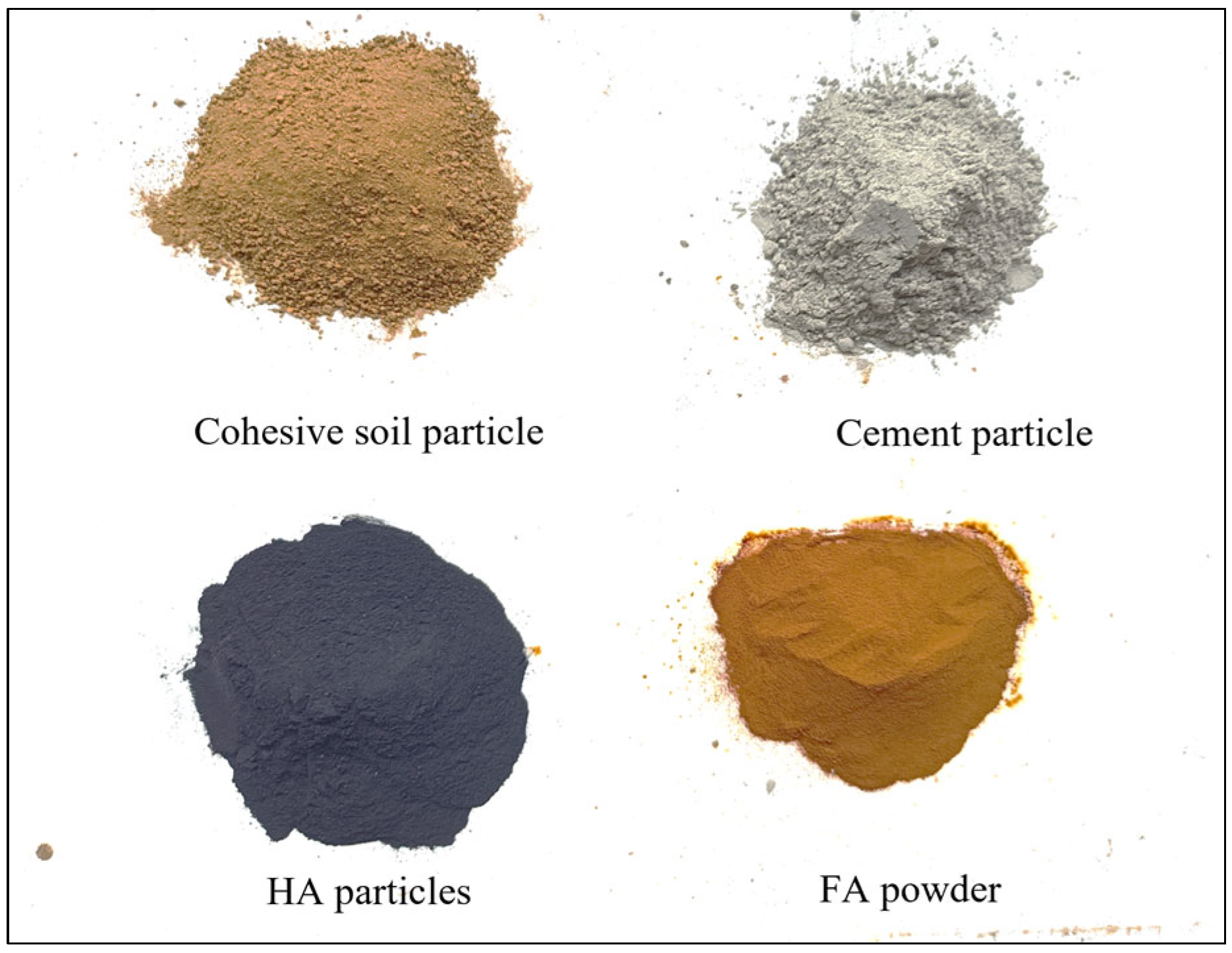
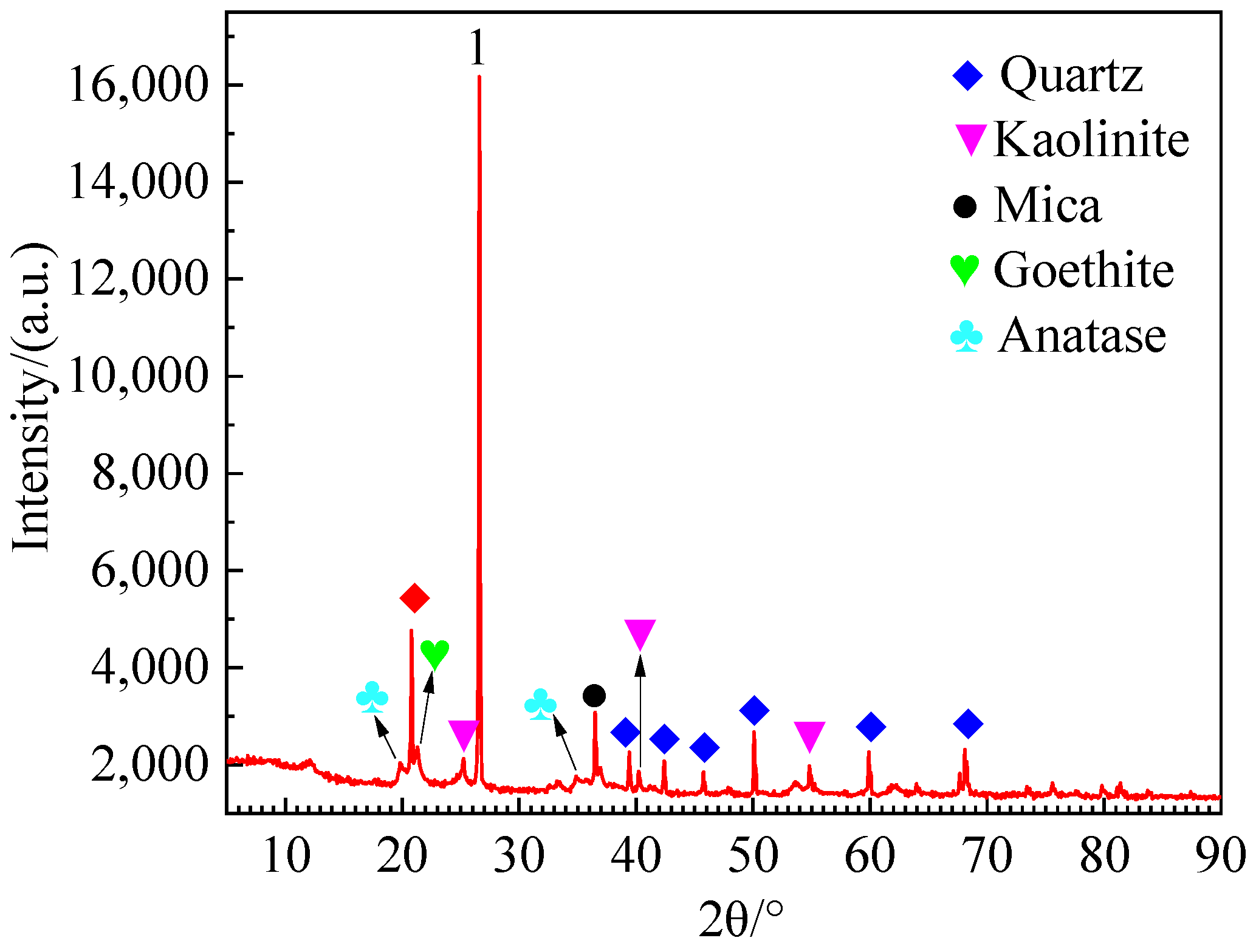
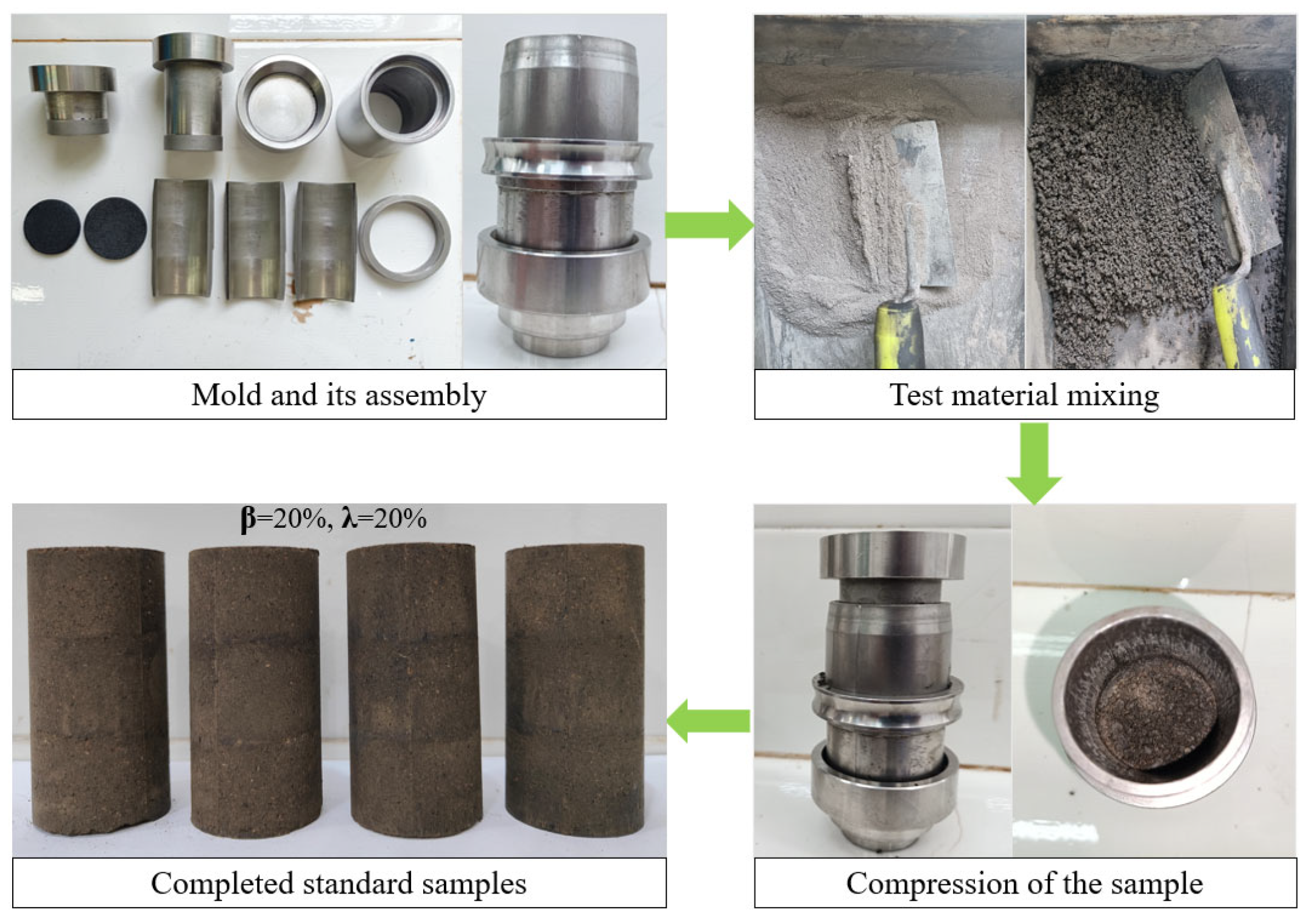
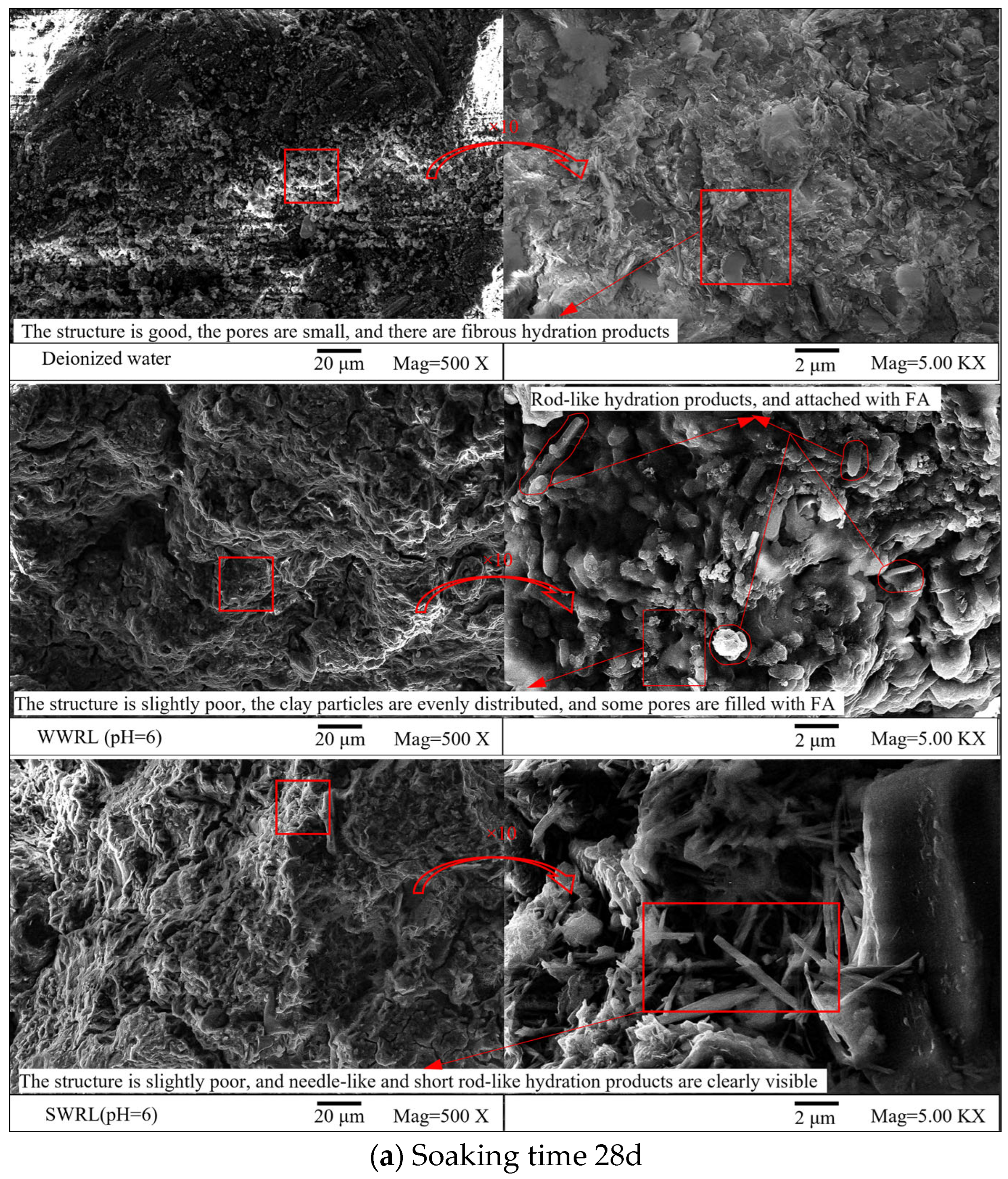
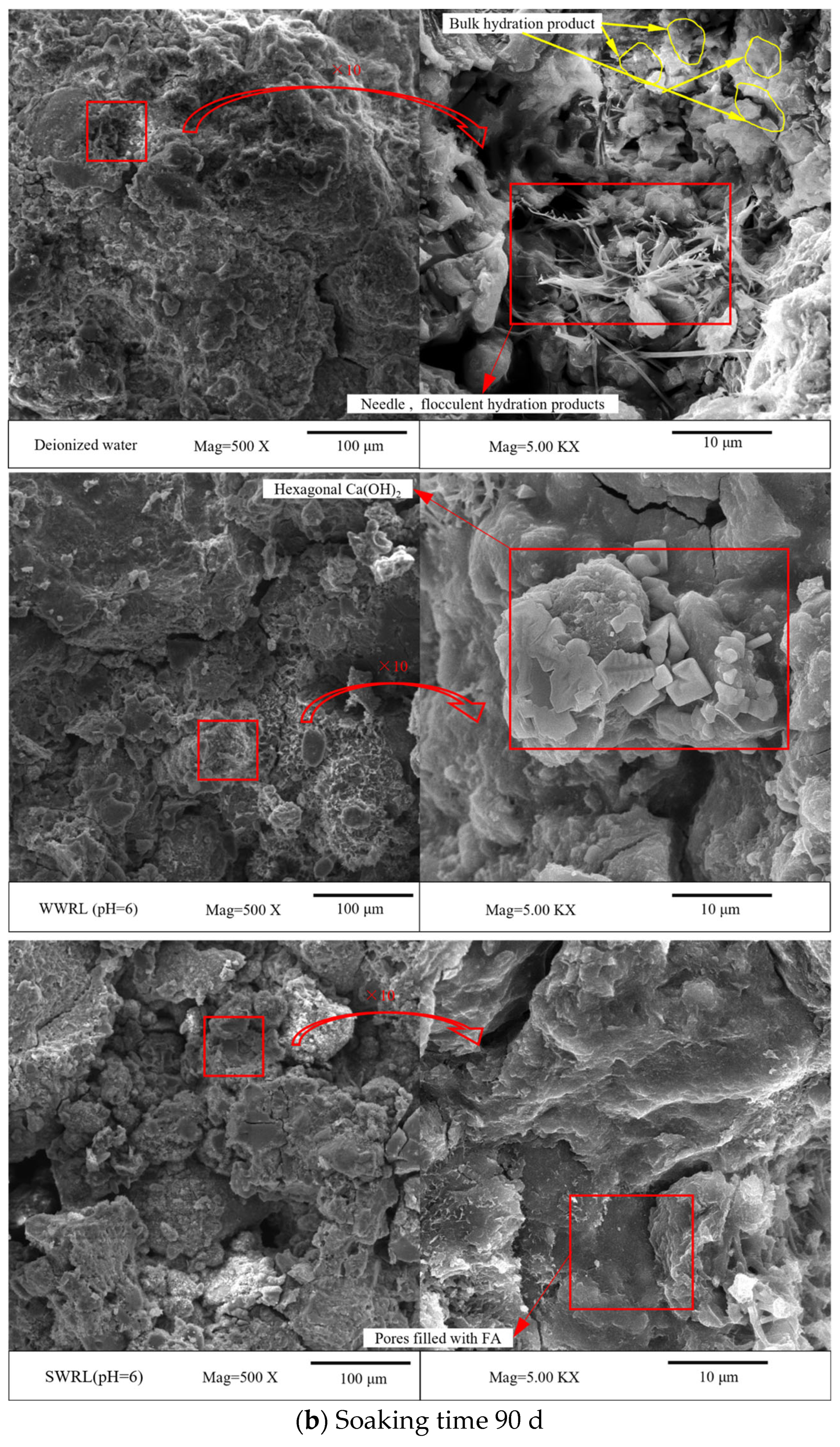


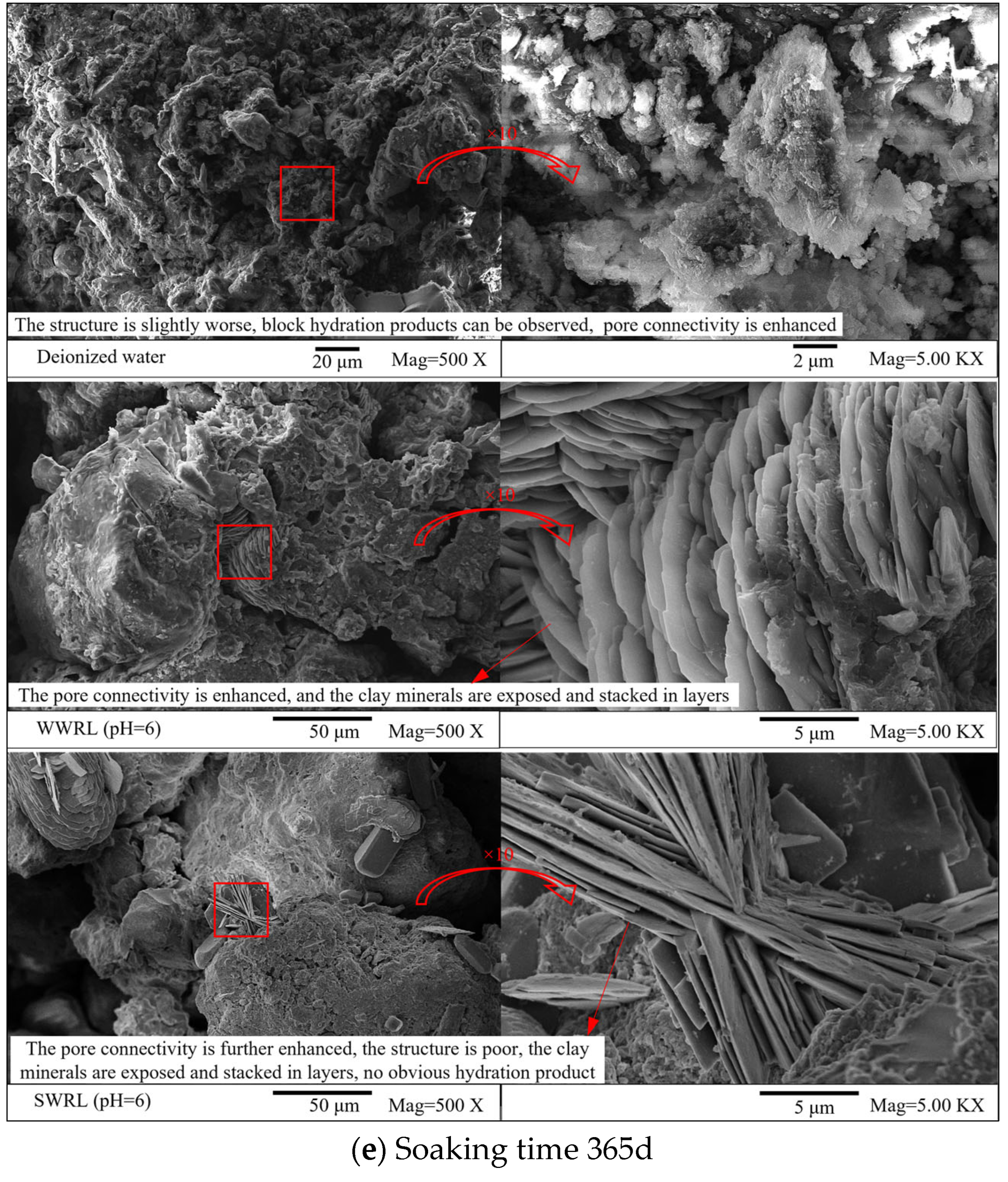


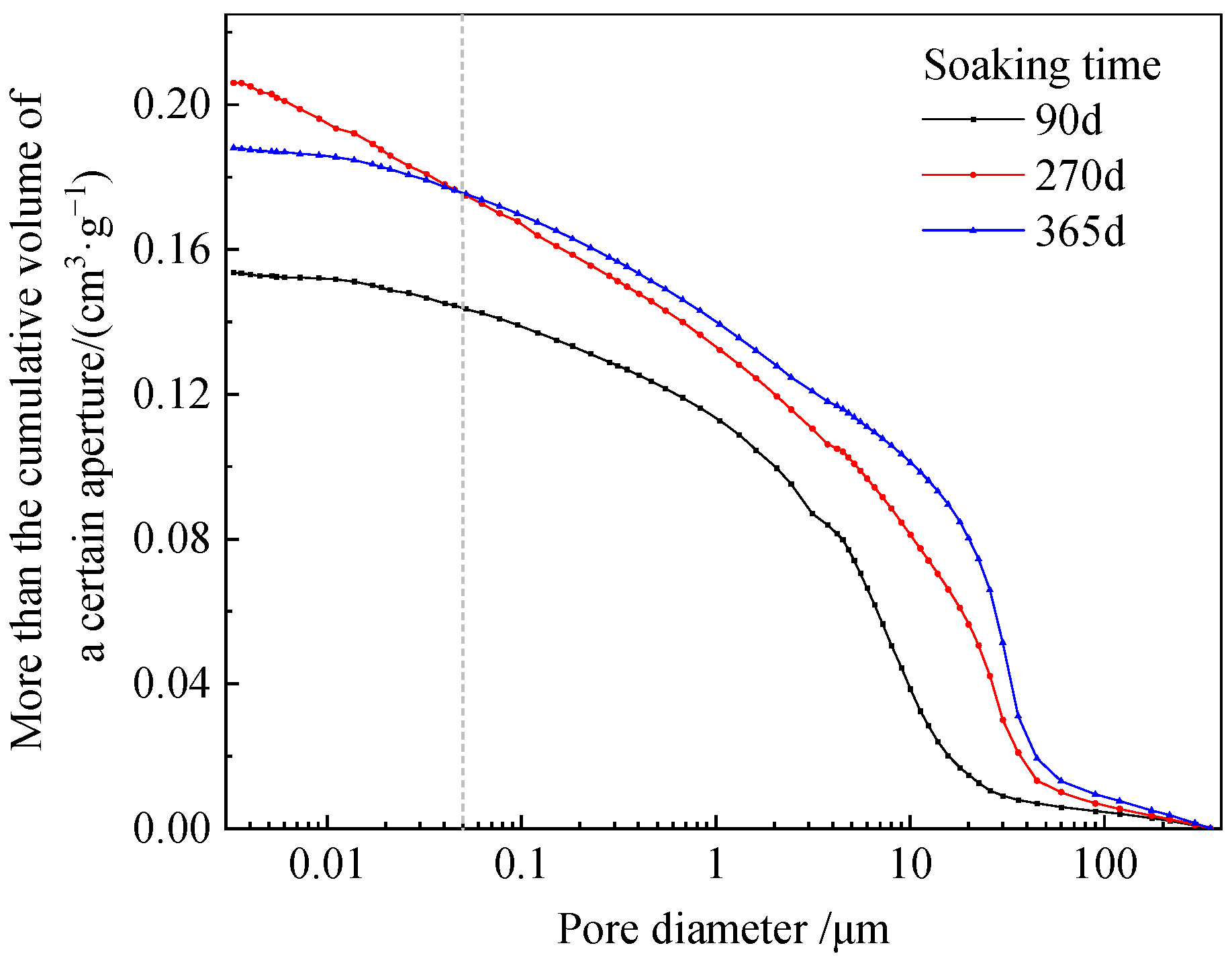
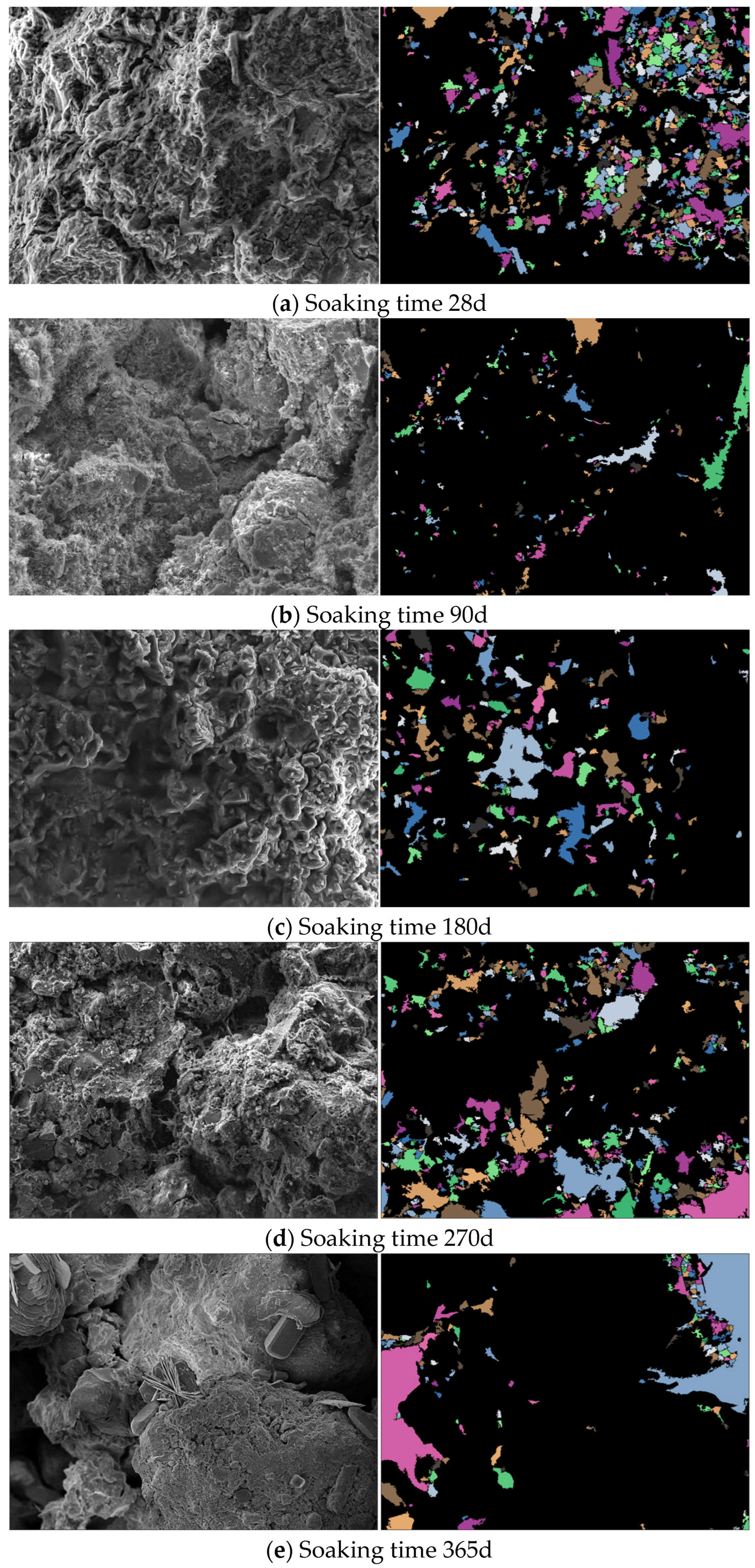
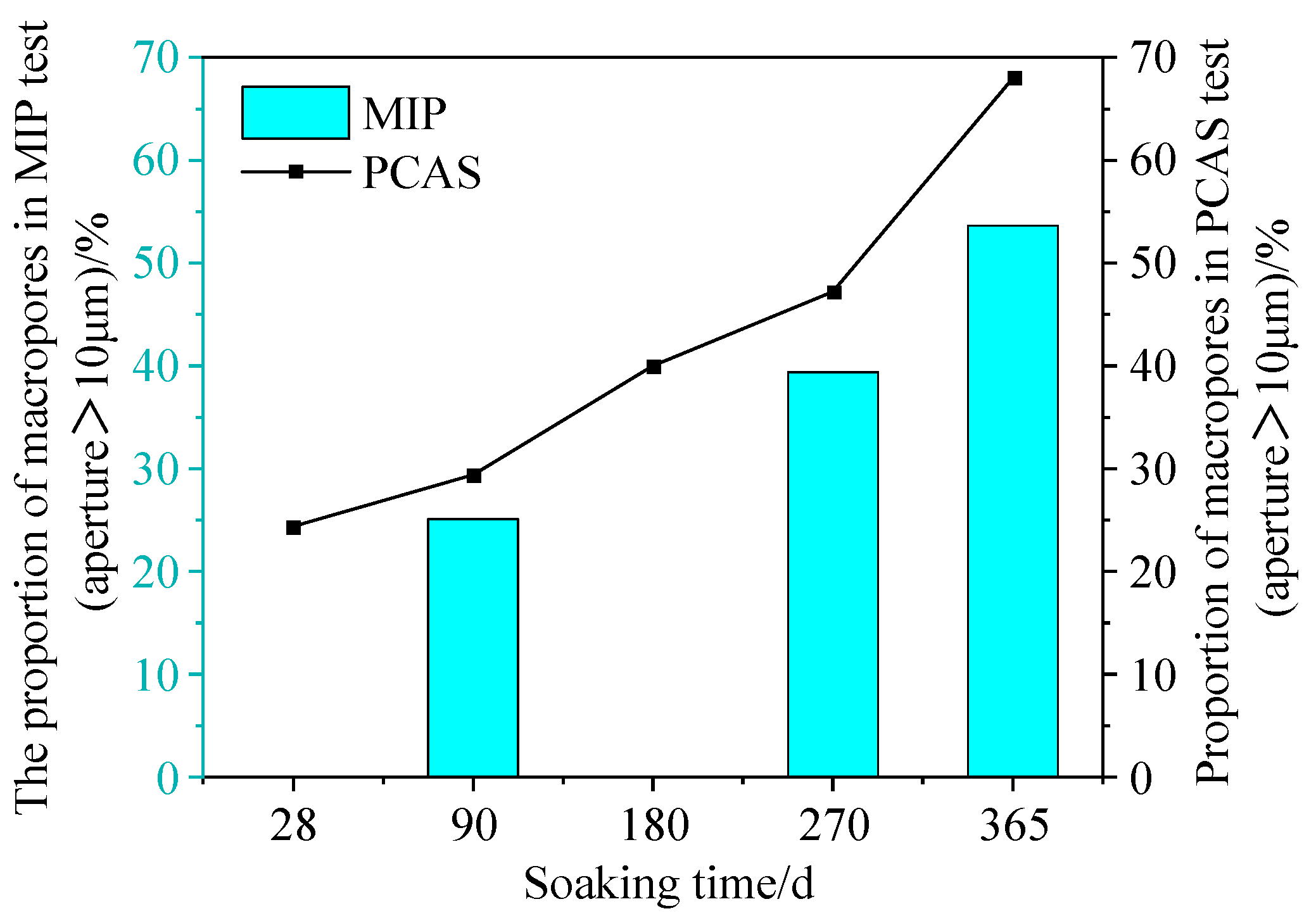

| Test Soil | Natural Water Content (%) | Liquid Limit WL (%) | Plastic Limit WP (%) | Natural Density (g·cm−3) | Grain Specific Gravity Gs |
|---|---|---|---|---|---|
| Cohesive soil | 18.60 | 39.20 | 23.00 | 1.96 | 2.84 |
| Test Soil | The Chemical Composition and Its Mass Fraction (%) | ||||||||||
|---|---|---|---|---|---|---|---|---|---|---|---|
| SiO2 | Fe2O3 | Al2O3 | TiO2 | K2O | MgO | CaO | Na2O | MnO | P2O5 | LOI | |
| Cohesive soil | 46.57 | 21.22 | 20.80 | 8.90 | 0.48 | 0.48 | 0.16 | 0.04 | 0.14 | 0.57 | 0.64 |
| Testing Item | Cement Mixing Ratio (β)/% | HA Content (λ)/% | Soaking Time/d | Soaking Solution |
|---|---|---|---|---|
| SEM | 20 | 20 | 28, 90, 180, 270, 365 | FA solution (pH = 6), Deionized water |
| MIP | 90, 270, 365 | FA solution (pH = 6) | ||
| PCAS | 28, 90, 180, 270, 365 | FA solution (pH = 6) | ||
| UCS | 28, 90, 180, 270, 365 | FA solution (pH = 6), Deionized water |
| Physical Properties of Cement-Soil Measured by MIP | Soaking Time/d | ||
|---|---|---|---|
| 90 | 270 | 365 | |
| Permeability/md | 39.0371 | 308.4046 | 597.4950 |
| Conductivity coefficient (calculated value) | 0.0820 | 0.0960 | 0.1310 |
Disclaimer/Publisher’s Note: The statements, opinions and data contained in all publications are solely those of the individual author(s) and contributor(s) and not of MDPI and/or the editor(s). MDPI and/or the editor(s) disclaim responsibility for any injury to people or property resulting from any ideas, methods, instructions or products referred to in the content. |
© 2023 by the authors. Licensee MDPI, Basel, Switzerland. This article is an open access article distributed under the terms and conditions of the Creative Commons Attribution (CC BY) license (https://creativecommons.org/licenses/by/4.0/).
Share and Cite
Cao, J.; Lei, S.; Liu, W.; Song, Y.; Sui, S.; Xu, H.; Guo, Y.; Ding, W. Experimental Study on the Corrosion of Fulvic Acid to Cement-Soil and Its Microstructures in the Peat Soil Environment. Coatings 2023, 13, 1366. https://doi.org/10.3390/coatings13081366
Cao J, Lei S, Liu W, Song Y, Sui S, Xu H, Guo Y, Ding W. Experimental Study on the Corrosion of Fulvic Acid to Cement-Soil and Its Microstructures in the Peat Soil Environment. Coatings. 2023; 13(8):1366. https://doi.org/10.3390/coatings13081366
Chicago/Turabian StyleCao, Jing, Shuyu Lei, Wenlian Liu, Yunfei Song, Sugang Sui, Hanhua Xu, Yongfa Guo, and Wenyun Ding. 2023. "Experimental Study on the Corrosion of Fulvic Acid to Cement-Soil and Its Microstructures in the Peat Soil Environment" Coatings 13, no. 8: 1366. https://doi.org/10.3390/coatings13081366
APA StyleCao, J., Lei, S., Liu, W., Song, Y., Sui, S., Xu, H., Guo, Y., & Ding, W. (2023). Experimental Study on the Corrosion of Fulvic Acid to Cement-Soil and Its Microstructures in the Peat Soil Environment. Coatings, 13(8), 1366. https://doi.org/10.3390/coatings13081366






